The majority of the Northern Australia Trip thus far had been spent in the savannah country of the Northern Territory and Queensland. This last part of the trip was spent in the wetter coastal strip of North Queensland with it’s associated change in both scenery and climate.
Continued from Northern Australia Part 3 – Wildlife of Outback Queensland
Lorenz flew in from Brisbane and with the luggage collected we made tracks for Townsville’s Breakawater Harbour, the departure point for Magnetic Island. Townsville Shuttle Servives provide excellent regular transport between the airport and Magnetic Island Ferry Terminals at $10 per person or $15 per couple.
There are upto 18 ferry sevices per day with vehicle free Sealink Ferry and the 8km journey to Nelly Bay on the island takes a mere 20 minutes. We sat on the top deck to watch the approach of the mountainous, green-cloaked peaks of the island, while a warm tropical breeze cleared the cobwebs from the earlier flight.
https://www.sealink.com.au/magnetic-island/
Wildlife of Magnetic Island
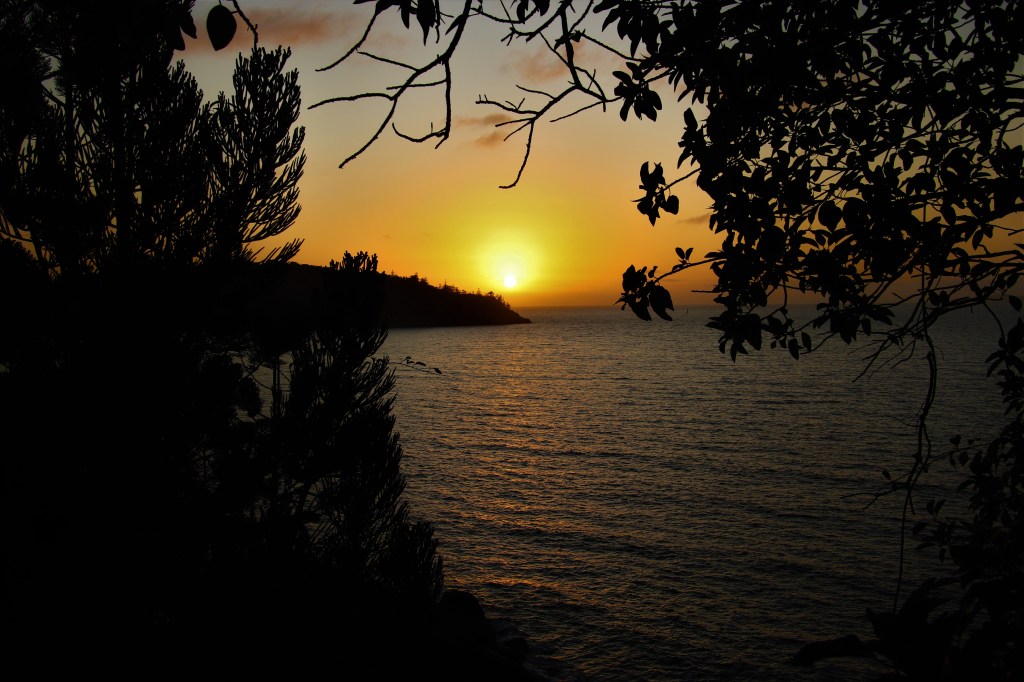
The priorities of Lorenz and I somewhat differed for the four nights on the island. Lorenz was intent on rest and relaxation, while my prime goal was of course the wildlife of Magnetic Island. The accommodation was at Nelly Bay near the ferry terminal, and was hands down the nicest accommodation of the entire four week trip.
That first evening we walked along the beach and out past the heliport, where a colony of Allied Rock Wallabies was discovered in the boulders of the harbour breakwater. The wallabies shelter in large cracks between the boulders by day, to emerge late evening and head out to the green spaces of Nelly Bay to feed. There were easily twenty rock wallabies on the sea wall at dusk. Some sitting and grooming, others vigoruously chasing each other over the rocks.
Allied Rock Wallabies.

The following morning at first light, while Lorenz slept I took a walk around Nelly Bay. There were only a couple of rock wallabies still active at this early hour. Two bird species were prominent in grassy vacant plots around Nelly Bay. The first was Magnetic Island’s signature bird the Bush Stone-Curlew, the other the Banded Lapwing. These ground nesting birds are less timid on Magnetic Island than mainland Australia.
Banded Lapwing.

The plan for that first day was to look for Koalas. The Koala was introduced to Magnetic Island in the 1930’s, with the current population now estimated to be 1500 animals. It seems the translocation to Magnetic Island was a judicious one, for despite the Koala being the faunal mammal for Queensland, it is real trouble in that state from a combination of mining, urban expansion, vehicle strike, dog attack and ever increasing bushfires.
The Forts Walk is touted as the best place on Magnetic Island to see Koalas. To reach the historic World War II fortifications, a return walking trail ascends a ridgeline for two kilometres from the bus stop on Horseshoe Bay Road to the ruins situated aloft a peak with magnificent views.
We saw a single Koala over the course of the walk. It was splayed out on a eucalypt branch high in the canopy and fast asleep. On our return, a crowd had gathered below the sleeping Koala with some people yelling at the animal to wake it for a photo. Unfortunately, visitors on the Forts Walk are encouraged to reveal the location of Koalas using sticks as arrows. While this provides a great opportunity for all to see a Koala, the constant disturbance is probably not in the best interest of the Koalas.
Back at the bus stop we had a short time to to wait for the next bus. Unable to sit still, I explored the beginning of a walking trail on the far side of the road linking the Forts Walk with Arcadia and Nelly Bay. This proved serendipitous because 50m along the trail was a Koala not only in the low fork of a tree, but decidedly awake. This tree was clearly a Koala favourite from the countless claw marks scarring the trunk.
Koala.

The famous site to view Allied Rock Wallabies on Magnetic Island is the Old Arcadia Jetty at Geoffrey Bay. Each morning I would walk over the headland from Nelly Bay to view these rock wallabies. It was once common practice to feed the wallabies, although fortunately these days this practice is discouraged. The result though are rock wallabies quite habituated to humans and easily observed.
Allied Rock Wallaby.

The coastal path from Nelly Bay to Geoffrey Bay passes through a strip of casuarina woodland behind the wide sweep of Geoffrey Bay, that I found to be an excellent daytime hang-out for Bush-Stone Curlews.
Bush Stone-Curlew.

The Bush Stone-Curlew is a ground nesting bird, that along with it’s fledgling young is prone to predation on the mainland from foxes and cats. Cats are present on the island but in low numbers. Magnetic Island is a stronghold for this species and is certainly the easiest place I have found to view them. They have a nocturnal whistling call that starts low, before gradually building to a repetitive, high-pitched wailing crescendo. Although it can seem eerie the first time it is heard, it is a strangely soothing sound on Magnetic Island to fall asleep to a chorus of curlews screeching in unison.
Bush Stone-Curlew.

There is a series of walking trails that criss-cross Magnetic Island. One walk proceeds from Nelly Bay to Arcadia via Forts Junction. On the last day I suggested that walk to Lorenz. It won’t take long I said…..It’ll be fun I said.
The trailhead for the walk at Nelly Bay is on Mandalay Road, and as we walked through surburbia there was a racket above from a giant gum where a Sulphur-crested Cockatoo was investigating a potential nesting hollow.
Sulphur-crested Cockatoo.

The steep climb from Nelly bay primarily followed a steep gully through dense rainforest, where despite plentiful shade there wasn’t a breath of wind. Conversely, the higher altitude eucalypt woodland had a healthy breeze but very little shade. The trail eventually crested the mountainous peaks of the island, from which there were superlative views to distant Townsville and Bowling Green National Park.
During the long descent to Arcadia we kept out eyes out for koalas in the eucalypt forest without luck. The final part of the walk traced the coast from Geoffrey Bay to Nelly Bay, by which time we had walked 8 kilometres taking the best part of three hours, effectively through mountains. I’m not sure the walk fitted the description I had sold to Lorenz prior to our departure.
That final night I spotlighted Nelly Bay Road South of town. The most common mammal seen by far was the Brushtail Possum, with ten animals seen over the course of the evening. The possums were found in a range of vegetation types from eucalypts and casuarinas to littoral rainforest.
Also seen were Bush Stone-Curlews, Agile Wallabies and a number of Black Flying-foxes feeding upside-down in the trees. The Flying-foxes could be residents of the island or they could have travelled from permanent camps in Townsville on a nightly migration. I think spotlighters are a rarity in Nelly Bay because I was blue-lighted by the local constabulary enquiring as to my activities!
Brushtail Possum in Liittoral Rainforest.

The following morning we returned to the mainland and Townsville Airport, which was by now starting to feel like a second home. Lorenz was heading to Brisbane and tempted as I was to join, the Atherton Tablelands were simply too close not to visit. The time in Cairns and the Atherton Tabelands was limited to three nights, but the area is so rich with wildlife, I knew the effort would be amply rewarded.
Wildlife of the Atherton Tablelands
It was a short hop from Townsville to Cairns landing late afternoon. Once the airport was cleared, I picked up a hire car and drove to a downhotel in Cairns. This was supposed to be a relaxing night in the city, but after checking an updated weather forecast it was clear wet weather was moving over the Atherton Tablelands the following day.
A site I wanted to revisit during this short trip was Mount Hypipamee. It sits 3000 foot above sea level and would be a certain casualty of the imminent inclement weather. In order to avoid spotlighting this forest not shrouded in rain and mist, then tonight was the sole opportunity.
Reluctantly I joined the Friday night traffic travelling South from Cairns on the Bruce Highway. At Gordonvale I exited at Gillies Range Road for the long climb to the Tablelands. Gillies Range Road is an impressive piece of infrastructure, where over a distance of only 19 kilometres there is an 800m elevation via an astounding 263 corners.
Arrival at the Atherton Tablelands after the bustle of the coastal plain is like stepping back in time. The quiet rural roads are quite familiar to me these days, and are almost devoid of traffic after dark. It had taken an hour from Cairns and it was a further 30 minutes to Mount Hypipamee. Approaching the elevated cloud forest I encountered the first mammal of the Tablelands in the form of a Northern Brown Bandicoot dashing across the road.
At Mount Hypipamee Carpark the air was brisk, almost cold. Spotlitghting among the rainforest giants along the entrance road were both Lemuroid and Herbert River Possums, while sounds on the forest floor revealed a Red-legged Pademelon.
After leaving Mount Hypipamee, but still at high altitude I stopped to spotlight along a road that ran adjacent to a patch of remnant rainforest. The most abundant mammals were the Coppery Brushtail Possums of which four were seen, but the highlight was a Lumholtz Tree Kangaroo feeding high in a treetop. This location also revealed another Lemuroid Possum, while a Long-nosed Bandicoot was busy foraging alongside the road.
Coppery Brushtail Possum.
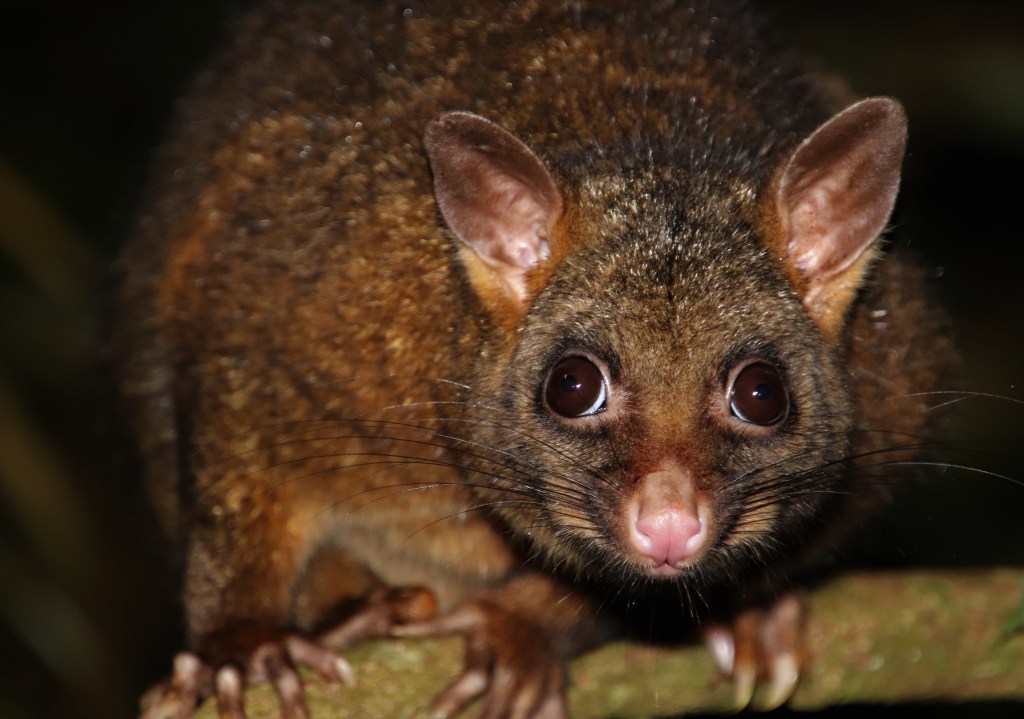
The following morning I checked out of the hotel in Cairns after only four hours of sleep, so much for the relaxing first evening! I stopped at Cairns Library to visit the Spectacled Flying-fox Colony only to find the trees devoid of Bats. Speaking with one of the resident gardeners, I was advised the colony had been recently dispersed to be resettled at Cairns Swamp.
Ever mindful worsening weather was approaching, I once again climbed the 263 corners of Gillies Range Road to the Atherton Tablelands where cloud had already began to blanket the sky. I picked up a much needed coffee in Yungaburra and wandered down to Petersen Creek.
At the creek there was a dismal change since the 2019 visit. Signage erected by a adjoining landowner advised that a 500m section of Petersen Creek was private property and not accessible to the public on account of an supposed biosecurity hazard. Further investigation in Yungaburra later that morning revealed the dispute to be before the council and by no means decided. In my opinion the claim is utter horseshit and a shame for visitors and the Yungaburra community alike.
Fortunately there remains plenty of walking trail available to the public, best accessed now from Penda Street in Yungaburra with all the parking headaches that presents for local residents. Petersen Creek along with Broken River further South in Queensland are the best platypus viewing in all of Australia. Local volunteers are doing a wonderful job revegetating the Creek and as well as platypus there is always a chance to see Lumholtz Tree Kangaroo.
Petersen Creek delivered in spades as usual, with a total of four Platypus were seen over the course of an hour mid-morning. One Platypus approached particularly close as it foraged along the creek diving and surfacing, while an Eastern Whipbird called with that long drawn out note followed by a whip-crack and then a few shorter notes. What a magical place!
Platypus.
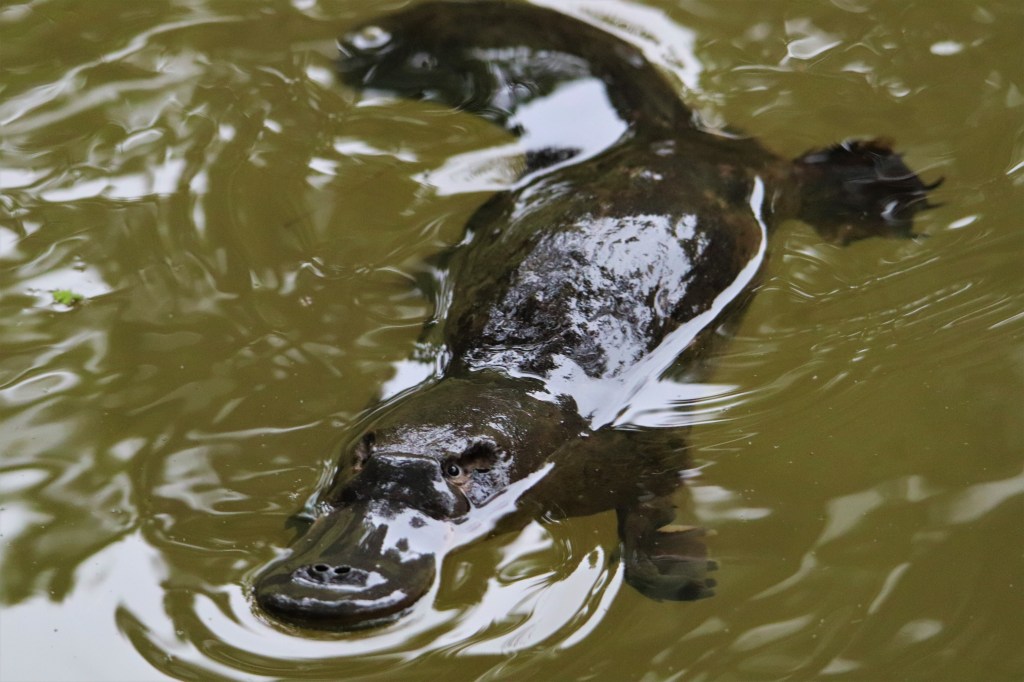
With more time to kill before check-in time at the accommodation, I drove to Nerada Tea Estate on the far side of Malanda where Lumholtz Tree Kangaroos reside in a narrow rainforest strip on the property. Once again there had been recent changes at this location with a considerable section of the property now closed to the public.
The closed-off area is an active workplace where forklifts are used, and so the closure is probably to comply with work and safety regulations, but it is a shame nonetheless. It is still possible to walk the strip of rainforest from the road for a chance with the Tree Kangaroos. I settled instead for a cup of tea.
Curtain Fig National Park
As cloud was now covering the higher altitude rainforests, I chose to spotlight the excellent Curtain Fig National Park. This National Park is a relatively small fragment of remnant tropical rainforest enclosed by farmland. The centrepiece is a massive 500 year old green fig tree (Ficus virens,) that has strangled a host tree and dropped aerial roots to the forest floor forming a massive curtain like something from Jurassic Park.
Curtain Fig.

Spotlighting the forest would be difficult were it not for an elevated 180m boardwalk around the giant curtain fig and Curtain Fig Road that bisects the forest.
Spotlighting from the road Coppery Brushtails were the first possums seen. Shortly after, in a tree slightly back from the road was a Green Ringtail Possum. I detoured a short distance into the forest for a better look which led to an unfortunate encounter with one of the rainforest plants, the aptly named Wait-a-While.
Wait-a-While (Calamus radicalis) is a climber that puts out tendrils armed with sharp hooks several metres long. These tendrils attach to neighbouring plants to climb and search for that most precious of rare resources on the rainforest floor, light. Once entangled, it took the best part of ten minutes to extricate myself from the stabbing tendrils resulting in a profusion of nasty scratches and ripped clothes.
Green Ringtail Possum.

Sound can be a useful sense when looking for mammals in the dense rainforest understory. Rustlings in the canopy often give away the presence of arboreal mammals in the absence of light.
The Giant White-tailed Rat is Australia’s largest rat, found throughout the rainforests of Queensland it will avoid white light. It often uses smaller vines to get around and in the darkness of the rainforest understory makes only quiet rustlings as it moves around.
Giant White-tailed Rat in Vine Thicket.

The noisiest of the forest mammals are the Tree Kangaroos. Known as mabu to the indigenous peoples, the loud thud and crash as they jump from tree to tree is unmistakable. I only had brief views of a distant Tree Kangaroo at Curtain Fig NP as it disappeared into the forest depths.
A reptile often located by eyeshine is the Northern Leaf-tailed Gecko. These camouflage experts face head down on the litchen-mottled bark of a giant tree trunk to ambush their insect prey.
Leaf-tailed Geckos can themselves become prey to larger nocturnal hunters. When threatened they have a clever response to avoid being eaten. The large leaf-shaped tail, similar in shape to the head, is wiggled to attract attention away from the head. In common with many gecko species they have the ability to then drop the tail and escape.
Northern Leaf-tailed Gecko.

While my attention was distracted photographing the gecko I had a second unfortunate encounter with a rainforest plant. The Stinging Tree (Dendrocnide moriodes) is Australia’s most poisonous plant to touch. It contains a neurotoxin similar to that of a spider and a disproportionately painful sting.
I was fortunate to be wearing long pants which spared me the full effect of the toxin, but I received enough poison to cause instantaneous and intense pain. While the worst of the pain had subsided within the hour, there was general discomfort for the remainder of the trip. Months after returning to Perth the neurotoxin would be reactivated by both showering and the cold morning air cycling to work. An unwelcome reminder of the trip to North Queensland……
Back at the wildlife lodge, there was a Striped Possum using the vines and tree trunks to move through the forest. This is my favourite of the rainforest possums for it’s attractive black and white pelage. In the photo below it is just possible to make out the elongated fourth toe used to extract insect grubs from rotten wood. Australia’s answer to a woodpecker.
Striped Possum.
The time was approaching midnight and I was surprised to be joined by another guest unable to sleep. While talking quietly there was a flurry of feathers and fur on a nearby tree trunk.
I swept the surrounding trees with a light to find an imposing Rufous Owl on a nearby branch, with a hapless Sugar Glider grasped firmly in it’s talons.
Rufous Owl with Sugar Glider Prey.

The Rufous Owl had wedged in the fork of a tree using the wings, from whence it had full use of the beak and talons. The Sugar Glider still alive was immobile from the combination of the strong talons and shock. In a determined motion the Owl broke the glider’s neck captured in the picture below, and the sound of crunching bones was clearly audible, Death was fortunately swift.
Rufous Owl with Sugar Glider Prey.

Writing this has elevated my heart rate as I relive the events of the night. It was an incredibly macabre, ghastly scene to witness, yet utterly awesome at the same time. I felt very privileged.
Lake Barrine
Crater Lakes National Park encompasses a pair of volcanic lakes surrounded by rainforest. Lake Barrine is the larger lake which I have previously found excellent for a charming rainforest specialist the Musky Rat Kangaroo.
Lake Barrine.
As a result of the wet weather, I had the entire 5km walking trail at Lake Barrine to myself. The rainforest canopy privided some shelter, with only an occasional raindrop trickling down the nape of my neck. To be in a rainforest when it is raining is to be alive, a thousand fragrant scents assaulting the senses.
The first animal seen was a Rusty Antechinus which gave an extended view as it darted quickly around the tree roots and through the leaflitter hunting for prey. I also saw a total of four Musky Rat Kangaroos, one animal especially well as it foraged on the walking trail around a corner.
Musky Rat Kangaroo.
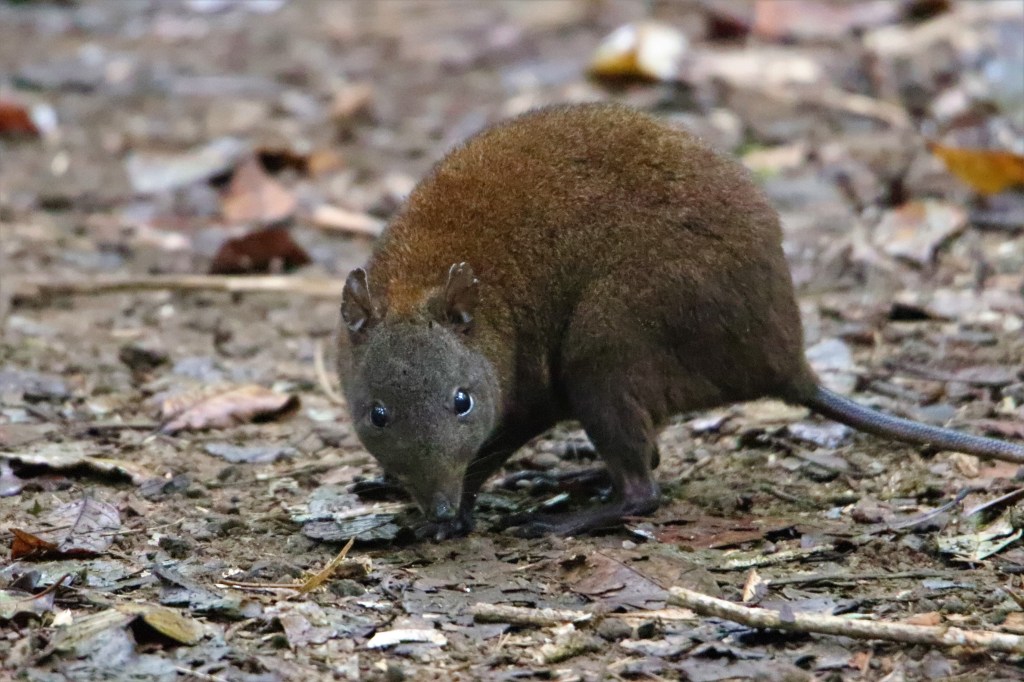
To prepare for the final spotlight, I walked the Rainforest Circuit Walk at Malanda Conservation Park late afternoon to see if anything was flowering that might deserve particular attention that night. During the walk in addition to turtles in the river, there was the occasional thump of pademelon feet as their shy owners disappeared into the depths of the forest.
The walking trail terminates at the Visitor Centre and on approach I could see a juvenile Red-legged Pademelon had ventured from the forest to feed. I had been reading up on stinging trees after my recent encounter and was impressed to find Red-legged Pademelons eat stinging tree leaves, sometimes the entire plant! Respect.
Red-legged Pademelon.
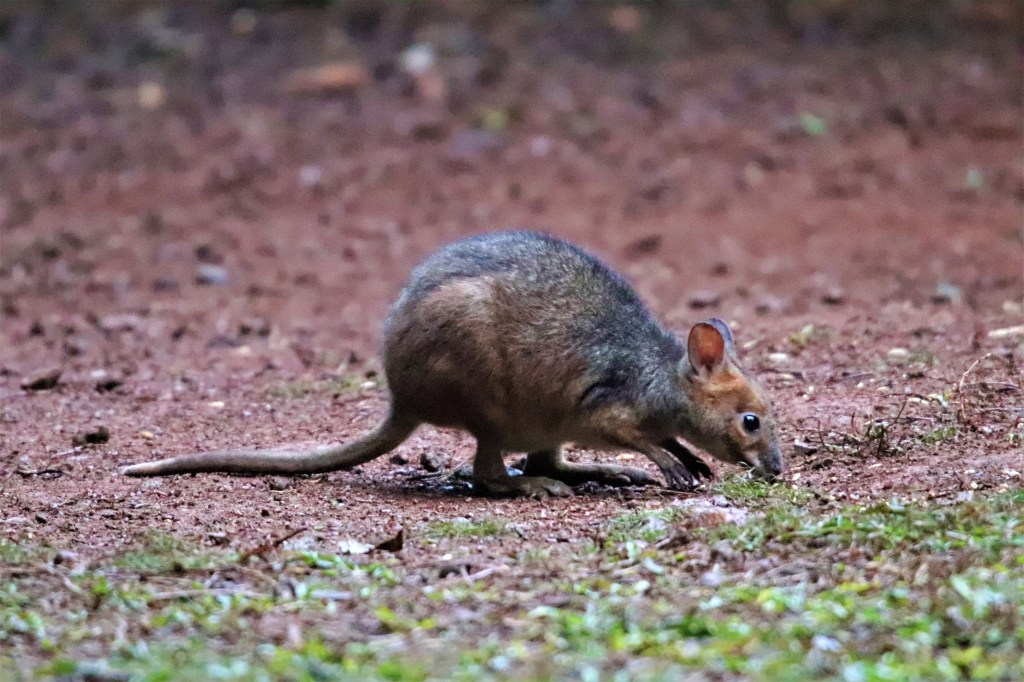
The spotlight at Malanda Falls Conservation Park that night was a washout. Despite the wet weather I did see two Giant White-tailed Rats. Curtain Fig National Park where I had spent the previous night, is at a slightly lower altitude and after travelling the ten kilometres to that site I found there to be no rain.
There were the usual Coppery Brushtails, Green Ringtails and Giant White-tailed Rats in the canopy, while rustling in the forest leaflitter revealed a Bush Rat and numerous Red-legged Pademelons and Long-nosed Bandicoots.
Long-nosed Bandicoot.

A enjoyed a few hours of spotlighting at Curtain Fig National Park, savouring the last of the rainforest, but eventually my luck ran out regarding the rain. Driving home, I had to swerve to avoid a Carpet Python. Once off the road I approached for a better look. The Python had a stupendously attractive colouration and was absolutely magnificent. Despite the beauty this snake had a rotten temper and took offence to the light, striking out with force. Reading the room, I took my cue to leave and headed home.
Carpet Python.

See below for a previous trip to the Atherton Tablelands in 2019
Queensland Wildlife 2019 – Part 3 of 4 – The Southern Atherton Tablelands and Undara Lava Tubes.
The following morning I descended from the Tablelands for the final time. It had been a great four weeks in sunny Northern Australia during Winter, but now the trip was at an end my mind turned to the upcoming trip to South Australia and the wildlife of that state, which would begin with a massive drive across the Nullarbor…..
#QuollingAround
Impressive!
LikeLike
Incredible photos Jimmy; especially of the owl catching the sugar glider, the leaf-tailed gecko and the platypus. Really enjoyed the amazingly vivid accounts of your wildlife discoveries and intrepid encounters with stinging trees, sharp climbers and an angry python. Your North Queensland entries are inspiring and we will use your tips and addresses for our future trip.
LikeLike
What an impressive set of animal, bird and reptile sightings. But you do wander around at night a bit more than we do. How do you know the names of everything you see?
The long-nosed Bandicoot looks very much like our Quenda. The owl and the glider sequence was amazing, almost as though the owl was proud of its catch. And it had worked out how to deal with the prey and still perch safely in a tree.
LikeLike
Hey Gordon I’m certainly out at night quite a bit! As for knowing all the names, I still have to look things up! Learning about the nature is a lifetimes work.
LikeLike